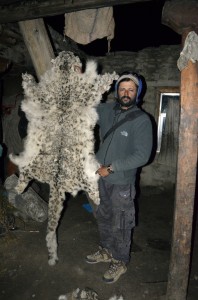“The study area is the most remote area in Nepal with no road access and the flights irregular. It took us nearly two weeks to reach our field site. Everything had to be carried from Kathmandu. The effort to manage the logistics was very tiring and we had to devote our energy more in these arrangements rather than starting field work which was the first and foremost challenge,” Said Mr. Raju Acharya, Director of Friends of Nepal in Kathmandu.
In 199 camera trap nights, no leopard were recorded. Raju was looking for other evidence of snow leopard, as well. While he found scrapes and scat, unfortunately, he also discovered 40 traps and three pelts.
The team recorded snow leopard signs in four out of ten transects (five scrapes, one scat and a large number of tracks all along the transect number 7) and recorded around 50 more scrapes outside those transects. “The encounter rate of signs (1.2 signs per km) in the transect was well below the encounter rate resulting in other studies, but the overall signs frequency was satisfactory (> 2 signs per km).”
Despite no-kill instructions from monks, Raju’s community surveys revealed a vibrant local trade in snow leopard with bones fetching $165 per kilo and pelts commanding $245.



